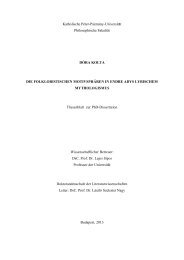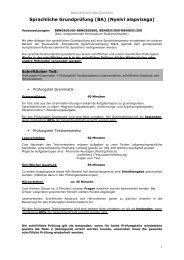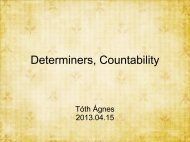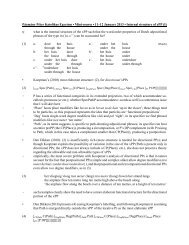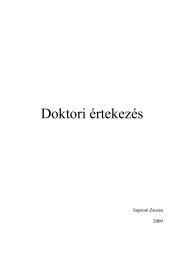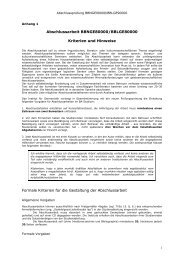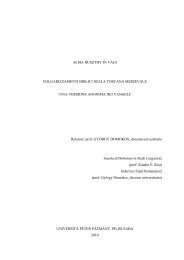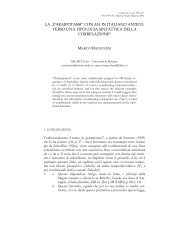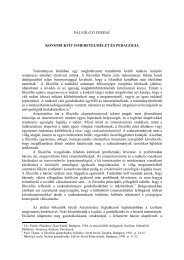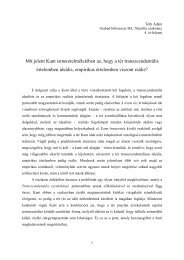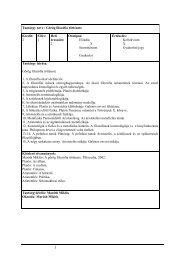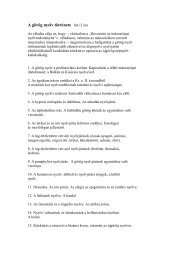“Ambisyllabicity” across word boundaries:
“Ambisyllabicity” across word boundaries:
“Ambisyllabicity” across word boundaries:
You also want an ePaper? Increase the reach of your titles
YUMPU automatically turns print PDFs into web optimized ePapers that Google loves.
(3) RP l-darkening<br />
a. alveolar (“clear”) l: leap, ballad, delicious, killer; kill Ann, kill a rat<br />
b. velar (“dark”) l: fall, fault, marble, Marble Arch, kill, kill Joe<br />
Again, l’s appear dark in exclusive rhyme (including nuclear and coda 3 ) position, (3b),<br />
and clear both when exclusively in the onset and when ambisyllabic, (3a). Since l does not<br />
have separate allophones for pretonic and non-pretonic environments, its variation cannot<br />
serve as an argument for (or against) ambisyllabicity (as opposed to resyllabification). For the<br />
sake of symmetry, however, we will suppose that the l’s in kill Ann or kill a rat are not<br />
resyllabified but ambisyllabic, thus falling under the same rubric as flapped t’s and tapped r’s.<br />
Thus, we can conclude that <strong>word</strong>-final consonants seem to be ambisyllabic due to the effect of<br />
a following vowel-initial <strong>word</strong>, and although ambisyllabification may only take place within<br />
<strong>word</strong>s if the vowel after the target consonant is unstressed, there is no such constraint on the<br />
stressedness of surrounding vowels at <strong>word</strong> <strong>boundaries</strong> (cf. Kahn 1976).<br />
2 Theoretical framework<br />
The framework that I choose for my analysis is Strict CV Phonology, a radical syllabic theory<br />
that sprung out of Government Phonology at the inspiration of Lowenstamm (1996). Not only<br />
does it deny the constituent status of the syllable and the coda but rejects all branching<br />
structures, and operates with regularly alternating C’s (standing for ‘non-branching<br />
onset’/’consonantalness’/’non-syllabicity’) and V’s (‘non-branching nucleus’/’vocalicness’/<br />
’syllabicity’), yielding strictly alternating CV skeletal units. Members of apparently branching<br />
constituents as well as adjacent segments of identical syllabicity sandwich empty positions,<br />
which are silenced by forces such as Proper Government. Following Dienes & Szigetvári<br />
(1999) and Szigetvári (1999) (who named their theory Coda Mirror Plus and drew heavily on<br />
Ségéral & Scheer (1999) and Lowenstamm (to appear), the latter suggesting an empty CV unit<br />
as a boundary marker identical to traditional #, beginning every <strong>word</strong> of a major category 4 ) I<br />
will assume the following:<br />
(4)<br />
a. Vocalicness is loud, not only acoustically but also in the sense that V slots in the<br />
phonological skeleton aim at being pronounced. (Szigetvári 1999: 62)<br />
b. Consonantalness is mute, if nothing intervenes a C position will stay silent. (Szigetvári<br />
1999: 62)<br />
c. Government spoils the inherent properties of its target. (Szigetvári 1999: 66)<br />
d. Licensing comforts segmental expression of its target. (Ségéral & Scheer 1999: 20)<br />
Therefore, a t is aspirated in a phonologically strong position, viz. when licensed but<br />
ungoverned; this situation emerges before stressed vowels (since they are unable to govern 5 )<br />
and <strong>word</strong>-initially (when the vowel’s governing potential is used up by the urge to silence the<br />
3 Syllabic l’s are supposed to reside in nuclear position. They have been included for the sake of completeness<br />
although their treatment is beyond the scope of the present paper.<br />
4 For the arguments see Lowenstamm (to appear), Larsen (1997) and Ségéral & Scheer (1999).<br />
5 More precisely, stressed vowels are unable to govern into another stress domain (dubbed the Antipenetration<br />
Constraint), which, since Dienes & Szigetvári work with VC (instead of CV) units forcing prevocalic consonants<br />
outside the vowel’s scope, results in “protected” pretonic consonants. Note however that the validity of this<br />
principle relies very much on having VC skeletal units. In a framework insensitive to the <strong>boundaries</strong> of units one<br />
might restate it as the inability of stressed vowels to govern into non-peripheral units (for ‘peripheral’ versus<br />
‘non-peripheral’ units see Szigetvári 1999 and Dienes 2000).



